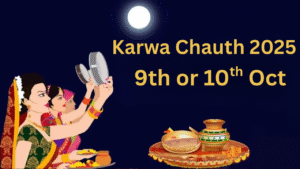Karwa Chauth is a deeply meaningful Hindu festival, especially in Northern and parts of Western India, where married women observe a strict fast (often nirjala, i.e. without water) from sunrise until moonrise, praying for the long life, well-being, and prosperity of their husbands.

While the date (for 2025) is already known — 10 October 2025 in India — the success and sanctity of the vrat depend heavily on following correct fasting rules, performing rituals in the right order, and avoiding missteps (don’ts). This article details everything you need to know: fasting guidelines, ritual sequence, dos & don’ts, health tips, and common FAQs.
Why Observe Karwa Chauth?
Understanding the why helps one observe with devotion and intent.
- Spiritual & marital devotion: The fast is seen as an act of love, faith, and discipline.
- Symbolic power of penance: Abstaining from food & water is considered a sacrifice to invoke divine blessings.
- Cultural continuity: The practice connects generations, maintaining ritual identity especially in northern India.
- Community bonding: Women often come together, share stories, perform group puja, and support each other through the challenge.
Fasting Rules (Vrat Guidelines)
The fasting rules are strict and must be followed carefully for the vrat to be considered valid in tradition.
1. Type of Fast — Nirjala (no water)
In most traditional observances, Karwa Chauth is a nirjala vrat, meaning no food or water from sunrise until moonrise.
Some variants (in exceptional or local practices) may allow drinking a little water in emergencies or under health constraints, but strictly speaking, that deviates from classical observance.
2. When to Begin the Fast
- The fast begins after Sargi (pre-dawn meal).
- One should finish Sargi before sunrise (or before the tithi boundary as per local panchang).
- After Sargi, nothing (not even water) should be consumed.
3. Duration
The fast continues from early morning through the entire daylight hours until moonrise (Chandrodaya). The fast is only broken after performing rituals and sighting of the moon.
4. What Is Prohibited During the Fast?
- Eating or drinking anything (unless extreme health emergency).
- Performing heavy manual labor or strenuous physical work; rest is encouraged.
- Wearing dark or impure clothes is discouraged (clean, auspicious clothes are preferred).
- Impure actions or thoughts: avoid anger, gossip, lies, negative speech.
- Using sharp instruments (some traditions discourage cutting nails/hair during the day).
- Breaking the fast prematurely even if the moon is not visible — one must adhere to correct ritual protocols.
Also read: Karwa Chauth 2025 Puja Muhurat: Fasting Start & End Time, Moonrise & Rituals
Ritual Sequence (Puja Vidhi) — Step by Step
Here is a generalized, commonly followed sequence of rituals during Karwa Chauth. Minor regional variations may exist, so please cross-check with your local family or priest.
| Step | Description |
|---|---|
| Preparations before sunrise | The fasting woman receives Sargi from her mother-in-law (or maternal side) — a nourishing, light, energy-sustaining pre-dawn meal. Often includes fruits, nuts, dairy, light grains, dry fruits. |
| Morning & daytime observance | After Sargi, the woman begins the fast — no food or water. She might carry out light chores (though many avoid household work) and maintain devotion, prayers, or meditation. |
| Evening adornment & mehendi | Women dress in festive clothes (saris, lehengas) often in auspicious colors (red, maroon, pink). Apply mehendi, bangles, jewelry, etc. |
| Gathering & puja assembly | Women often gather in groups (temples or homes) with puja thalis (plates) containing required items: Karwa (earthen pot), diya (lamp), raw milk, sweets, flowers, vermilion (sindoor), etc. |
| Recitation of the Vrat Katha / Story | A priest or elder narrates the Karwa Chauth story (Veeravati, the reversal of death, etc.). Women listen, sing devotional songs or “feris” (chanting in rounds). |
| Performing Arghya to Moon | After moonrise, women view the moon through a sieve (symbolically filtering energies), offer arghya (water) to the moon, then look at their husbands’s face through the sieve — the husband offers first sip of water or bites to break the fast. |
| Breaking the fast | After the moon sighting ritual, the fast is broken with light food (fruits, milk, sweets). Heavier meals are taken gradually. |
Symbolism of the sieve (chalni): The sieve holds a special place — women use it to view the moon and then their husband’s face. This act symbolizes purification, devotion, and the filtering of negativity.
Dos & Don’ts (Important Guidelines)
Below is a consolidated list of “Dos & Don’ts” to ensure that the vrat is observed respectfully, safely, and in line with tradition.
✅ Dos
- Eat a wholesome Sargi
Include balanced nutrition — slow-release carbs, protein, light fats, hydration (via milk/curd) and fruits. This helps sustain energy throughout the fast. - Rest and conserve energy
Avoid strenuous activity; take rest, avoid overexertion. Conduct rituals with calmness. - Stay mentally positive
Maintain pure thoughts, avoid negative speech, anger, conflict. Focus on devotion, prayer, and gratitude. - Use clean, auspicious clothes & adornments
Dress in clean, traditional attire; use flowers, bangles, mehendi to feel devotional. - Collect and prepare puja items in advance
Keep everything ready: Karwa, lamp, raw milk, sweets, sindoor, water lota, etc., to avoid last-minute rush. - Follow the Katha & perform rituals attentively
Listen/recite the vrat story, sing songs, perform “feris” (if your tradition) faithfully. - Break the fast gently
Begin with light, easily digestible foods (milk, fruits) then gradually resume normal food. - Hydrate post-fast
After breaking, drink adequate water or electrolyte fluids to replenish.
❌ Don’ts
- Don’t eat or drink anything during the fast
Even a small sip, unless for grave health reasons, may invalidate the nirjala vrat. - Don’t engage in strenuous work or travel
Physical exertion may weaken the body; avoid heavy chores or long commutes. - Avoid negative speech, gossip, anger
The fast is also about purity of mind — refrain from arguments, ill thoughts, slander. - Don’t wear impure or unclean clothes
Avoid black, dirty, or torn garments — aim for purity and respect in dress. - Avoid cutting nails, hair, or using sharp tools during the day
Some traditions discourage these actions as they symbolize breaking purity. - Don’t skip the rituals or story/Katha
The ritual structure gives the vrat spiritual power; skipping may diminish the observance. - Do not break fast prematurely even if moon isn’t visible
Wait for moonrise or follow alternative local guidelines. - Don’t consume heavy oily or spicy food immediately after breaking
Such food can shock the digestive system — start light.
Health & Practical Tips (Surviving the Fast)
Observing a nirjala fast is taxing — so here are some practical, health-conscious tips:
- Hydrate well before dawn: In Sargi, drink fluids (milk, buttermilk) but avoid overdoing sugar or salt.
- Include slow-release carbs and protein: Use grains like millets or light chapatis, dairy, nuts, seeds.
- Avoid tea/coffee during Sargi: These are dehydrating. Better to use buttermilk, coconut water, or light herbal drinks.
- Avoid fried, oily, excessively spicy or heavy food on Sargi: It may cause discomfort later.
- Rest periodically: Take short naps, relax, avoid stressful activity.
- Mind your surroundings: Stay in shade or indoors during peak heat, avoid excessive walking.
- Break fast mindfully: Begin with water, fruits, or milk followed by light kichdi, curd, etc. Avoid heavy fest foods at once.
- Be alert to health warning signs: If weakness, dizziness, dehydration symptoms become severe, consider medical assistance or guided break of fast.
Conclusion
Karwa Chauth is much more than a ritual fast — it’s an expression of faith, devotion, and discipline. Observing it correctly in 2025 means understanding and adhering to the fasting rules, performing the ritual sequence faithfully, and avoiding missteps. With mindful preparation, rest, and reverence, the vrat can be both spiritually rewarding and physically manageable.
Also read: Karwa Chauth 2025 Date & Time — Delhi, Mumbai, Jaipur & City-wise Timings
Frequently Asked Questions (FAQs)
In classical tradition, yes — the Karwa Chauth vrat is meant to be nirjala from sunrise to moonrise. However, in exceptional cases (health conditions) some adjust the observance.
In such cases, many follow the alternative given by local priests or use moonrise time from a nearby location to perform the rituals.
Yes, many unmarried women observe it praying for a good life partner or spiritual blessings — though some ritual steps may adapt.
If it is urgent and advised by a doctor, yes — health comes first. But it is better to consult a priest and medical professional, and possibly perform a partial or alternative fast.
Slow-release carbs (millets, whole grains), dairy (milk, curd), nuts/dry fruits, light proteins, fruits; avoid sugary or fried heavy stuff.
After moonrise, once you’ve seen the moon (through sieve), offered arghya, and completed the puja ritual.
It’s not advisable — the Katha is integral to the ritual’s power and meaning.
While not mandatory everywhere, many women choose auspicious colors like red, maroon, pink, gold — clean and festive.
It’s better to minimize chores and avoid heavy work. Some light household tasks may be acceptable depending on tradition.
Start with light, digestible food (fruits, milk), then gradually move to a normal meal. Avoid immediately jumping into heavy, oily, or fried foods.





